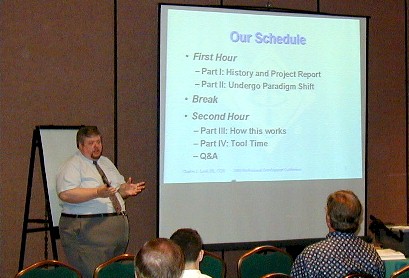Volume 15 Number 2
September 2000
| Region 3 Newsletter Volume 15 Number 2 |
Page 5 | September 2000 |
 |
Electronic Conferencing 101Charles J. Lord, PE |
The principles of electronic conferencing are very simple and surprisingly low-tech. As Bill Ratcliff, the Chair of this project, likes to say, "It ain't the technology - it's the method." There are many ways of conferencing and collaborating over the internet, but we are faced with volunteers with various types of equipment and Internet Service Providers (ISPs) of varying capabilities; thus we are forced to find a "lowest common denominator" system that gives us good results without high-bandwidth ISPs or making you buy cameras, microphones, or special software. If you can connect to the internet well enough to send and receive email and browse web pages, you can probably do everything I am going to describe here.
The most basic form of econferencing is what we call "Sync" or synchronous mode. It involves having everyone on-line at the same time like a face-to-face meeting or teleconference. We use a mode called Internet Relay Chat (IRC, or "chat") to all talk together in a common "room" or "channel". Control is kept by following some simple but critically important rules:
There are some basic overall rules that also must be followed for the meeting to be successful. These are:
The clients for Windows 95/98/NT/2000 that we recommend are MSChat by Microsoft and mIRC from mIRC. URLs for these products are found at https://www.ewh.ieee.org/reg/3/e-conf/guidelines/ircinfo.html. MSChat is free, and mIRC is shareware; however, the author of mIRC has given IEEE permission to use his product for free. (the product is only $20, so please send the guy the money if you use the product) Installing the software is very straightforward, and instructions are available at the above URL.. There is also a list of chat clients for Mac and Linux (Unix) machines at that location.
To join a meeting, log into the IEEE Chat server and join the channel that is listed in your meeting notice. This channel, or room, will have a name that starts with "#", for example, #r3econf is the usual name for the region 3 econf committee's meeting room.
The structure of a common sync econf is as follows:
Before the meeting:
The facilitator and/or the sponsor post the agenda, identifying who is responsible for
each topic. Those people who are to give reports submit those reports to the facilitator
for posting on the group's website, linked to the appropriate agenda item.
(see https://ewh.ieee.org/reg/3/excom/meetings/2000-01/agendas.html
for an example)
Day of the meeting:
The facilitator logs onto the server and agreed-to channel at least 15 minutes early. The facilitator sets the topic of the channel to the name of the meeting and its starting time.
The other attendees log in and join the channel before the starting time
At the agreed-to starting time, the facilitator begins the meeting by welcoming all and posting the agenda to the channel. They then ask for changes and additions to the agenda, which are noted.
The facilitator then goes through each item:
At the end, the facilitator then thanks all for participating, recaps action items or areas of responsibilities, sets the time and date of the next meeting (if applicable), and ends the meeting. The facilitator then saves a copy of the log of the meeting and posts it to the group's website (if applicable). The log may be edited into formal meeting minutes if desired. An example of a meeting log is at https://ewh.ieee.org/reg/3/e-conf/logs/econf-2000-03-14.html .
As you can see, the principles are simple, but they work wonders for your group if they are followed carefully. Although an econf may take longer (particularly at first, until you get used to it) and lacks the non-verbal communications of a face-to-face meeting, when you factor in the travel time and expense, it is much more efficient, costs much less, and is less intrusive than a face-to-face meeting.
Previous Table Of Contents Next
|